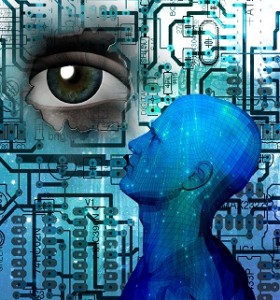13 Mar Intro to Understanding Context
Understanding
It has been said that it is not possible to fully understand another person’s meaning without inhabiting their experiences and their current state of mind. And yet, communication is often completely successful. The most effective communications are between people who empathize well and avoid applying their own biases when listening to others. For humans, often active listening is enough to overcome the the deficit of a listener not knowing the speaker’s history. But the more history the listener knows, the more complete understanding can occur. Knowing the history is context. The more context a listener brings to a dialog, the better able the listener is to comprehend the deep underlying intent of the speaker. Modeling context and human level understanding in computers is made more difficult because a computer has no kinesthetic sense of what it is to be human. But I propose that the more context an automated listener brings to a dialog, the better it will be able to interact in ostensibly empathetic ways. Defining a model for digital systems to achieve understanding through context is the point of this blog.
From Information To Knowledge
To move from the information age into the age of knowledge with any efficiency, the ways automated devices handle content must change. It’s automated devices instead of computers, because the phenomenon of automated information processing is evolving very rapidly, leaving us with a huge choice of devices. But, we still have the same old information processing techniques that have been around for decades. There are no systems that approximate brain structure, processes or capabilities. “Sometime this century, machines will surpass human levels of intelligence and ability. This event—the “intelligence explosion”—will be the most important event in our history, and navigating it wisely will be the most important thing we can ever do” (Muehlhauser 2013 – Intro). So, to the end of navigating it wisely, or even precipitating the explosion a bit more quickly, I propose we begin by teaching machines to better understand context.
Some of the new wrappers for data and processes, such as mobile apps, are very nice, and many take advantage of the context of individual profiles, past behaviors and geographical locations.. And maybe they’re good enough; but with the growing mountain range of available online information, especially associated with social networking, I think we need smarter approaches. I think systems need to understand and process more context, and I think we need to get closer to how the brain handles information and knowledge. But first, we have to have a formal definition of how the brain handles knowledge. Jeff Hawkins, mobile device pioneer and intelligent systems designer points out that: “The field of neuroscience was awash in details. It still is. Thousands of research reports are published every year, but they tend to add to the heap rather than organize it. There’s still no overall theory, no framework, explaining what the brain does and how it does it” (Hawkins, 2004 p.33).
I will not answer these tough neuroscientific questions in this blog, but I will look inside the brain, its cells, and the way they pass electrical impulses around, as a basis for suggesting a brain-like model for using more context to better understand human language.
| Understanding Context Cross-Reference |
|---|
| Click on these Links to other posts and glossary/bibliography references |
|
|
|
| Prior Post | Next Post |
| This is the Beginning | What’s the Point (of this blog)? |
| Definitions | References |
| knowledge processing | Hawkins 2004 |
| computers information | Glossary Coulson 2001 |
| data context | Bibliography Muehlhauser 2013 |
In Semantic Leaps, Seana Coulson, speaking of Neil Armstrong’s “Giant Leap” suggests that “Like interpretation of an action such as stepping onto the moon, interpreting the meaning and significance of natural language utterances depends crucially on contextual factors and background knowledge” (Coulson 2001). Context is often considered to include the time, the location, the topic of discussion and other obvious factors that affect what we are talking about. Background knowledge, including exformation and subtext may also be included in context. I assume that systems that are broadly capable of delivering users actionable knowledge will be based on deep understanding of context.
Dictionary.com suggests that context is:
context [kon-tekst]
noun
- what comes before or follows a word or statement and influences its meaning
- circumstances
 For this blog, the primary focus is on word sense number 2, and the secondary is on word sense number 1. The term “word sense,” and the plurality of senses for so many words, is the crux of the issue. To make sense of the world around us we need circumstantial evidence (number 2.) To communicate it to other people, we need human language: words that are strung together to represent meaning (number 1.) It will also be helpful to understand how our brains deal with complex tasks like language understanding. Would a person living in the 1700s be able to understand the word “e-Commerce” or even be able to interpret a picture of mountains taken from an airplane? The absence of essential context may make it impossible.
For this blog, the primary focus is on word sense number 2, and the secondary is on word sense number 1. The term “word sense,” and the plurality of senses for so many words, is the crux of the issue. To make sense of the world around us we need circumstantial evidence (number 2.) To communicate it to other people, we need human language: words that are strung together to represent meaning (number 1.) It will also be helpful to understand how our brains deal with complex tasks like language understanding. Would a person living in the 1700s be able to understand the word “e-Commerce” or even be able to interpret a picture of mountains taken from an airplane? The absence of essential context may make it impossible.
I have some distinct observations on understanding context and its role in cybernetics that I am inclined to share with you. I am hoping that many of you will read and contribute to this dialog. Thank you for your interest – let’s begin the exploration, and see how close we can come to bridging the knowledge gap.
| Click below to look in each Understanding Context section |
|---|
| Intro | Context | 1 | Brains | 2 | Neurons | 3 | Neural Networks |
| 4 | Perception and Cognition | 5 | Fuzzy Logic | 6 | Language and Dialog | 7 | Cybernetic Models |
| 8 | Apps and Processes | 9 | The End of Code | Glossary | Bibliography |










